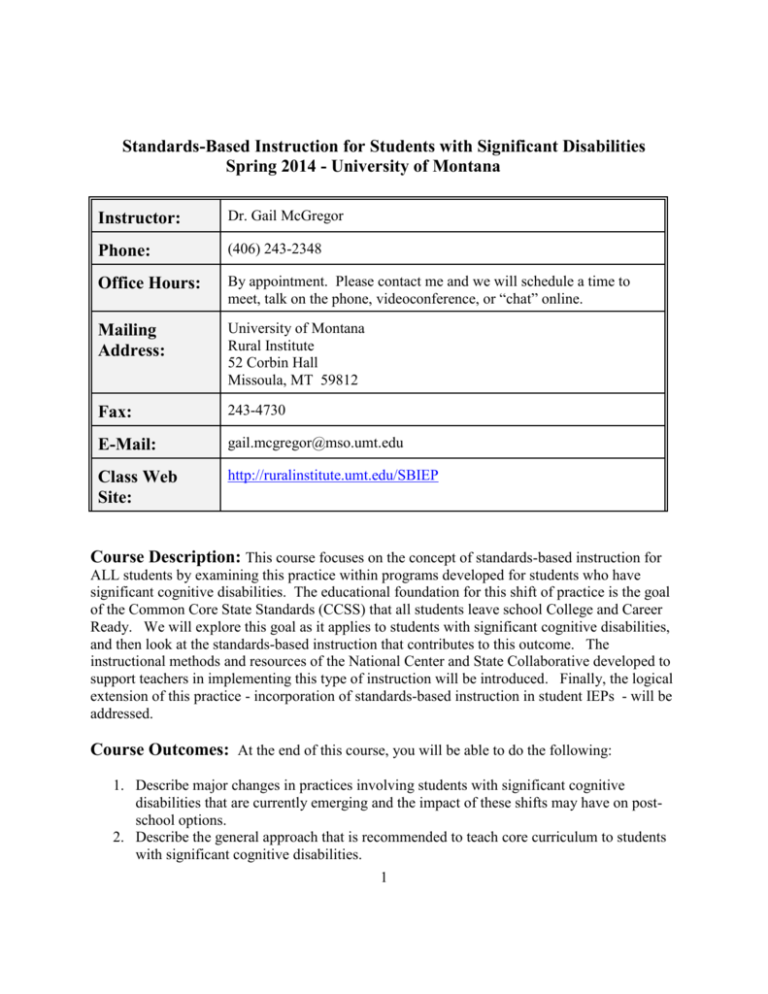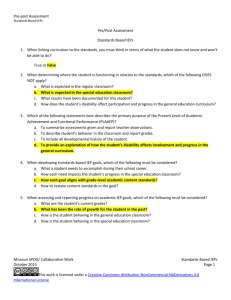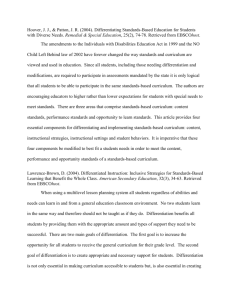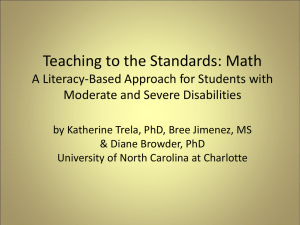Standards-Based Instruction for Students with
advertisement

Standards-Based Instruction for Students with Significant Disabilities Spring 2014 - University of Montana Instructor: Dr. Gail McGregor Phone: (406) 243-2348 Office Hours: By appointment. Please contact me and we will schedule a time to meet, talk on the phone, videoconference, or “chat” online. Mailing Address: University of Montana Rural Institute 52 Corbin Hall Missoula, MT 59812 Fax: 243-4730 E-Mail: gail.mcgregor@mso.umt.edu Class Web Site: http://ruralinstitute.umt.edu/SBIEP Course Description: This course focuses on the concept of standards-based instruction for ALL students by examining this practice within programs developed for students who have significant cognitive disabilities. The educational foundation for this shift of practice is the goal of the Common Core State Standards (CCSS) that all students leave school College and Career Ready. We will explore this goal as it applies to students with significant cognitive disabilities, and then look at the standards-based instruction that contributes to this outcome. The instructional methods and resources of the National Center and State Collaborative developed to support teachers in implementing this type of instruction will be introduced. Finally, the logical extension of this practice - incorporation of standards-based instruction in student IEPs - will be addressed. Course Outcomes: At the end of this course, you will be able to do the following: 1. Describe major changes in practices involving students with significant cognitive disabilities that are currently emerging and the impact of these shifts may have on postschool options. 2. Describe the general approach that is recommended to teach core curriculum to students with significant cognitive disabilities. 1 3. Identify at least three resources from the National Center and State Collaborative that a teacher would find useful in planning and delivering standards-based instruction to students with significant cognitive disabilities. 4. Describe how the writing of standards-based IEPs supports this process. Required Readings: In keeping with the Fair Use copyright guidelines for education, it is permissible for each class member to download a single copy of the assigned readings for educational purposes. An alphabetical list of the readings for this class is provided below. The Course Schedule tells you when readings as assigned. Ayres, K. M., Lowrey, K. A., Douglas, K. H., & Sievers, D. (2011). I can identify Saturn but I can’t brush my teeth: What happens when the curricular focus for students with severe disabilities shifts. Education and Training in Autism and Developmental Disabilities, 46(1), 11-21. Cortiella, C. (2008). Understanding the standards-based IEP. Advocacy Brief, National Center for Learning Disabilities. Courtade, G., Lingo, A. S., Karp, K. S., & Whitney, T. (2013). Shared story reading: Teaching mathematics to students with moderate and severe disabilities. Teaching Exceptional Children, 45(3), 34-45. Courtade, G., Spooner, F., Browder, D., & Jimenez, B. (2012). Seven reasons to promote standards-based instruction for students with severe disabilities: A reply to Ayres, Lowrey, Douglas, & Sievers (2011). Education and Training in Autism and Developmental Disabilities, 47(1), 3-13. Griffin, C., Owens, L., Roberts, K., Nord, D.,& Gaylord, V. (Eds.). (Winter/Spring 2012). Impact: Feature Issue on Supporting New Career Paths for People with Intellectual Disabilities, 25(1). Minneapolis: University of Minnesota, Institute on Community Integration. Retrieved online at: http://ici.umn.edu/index.php?products/view/467. Hock, M. (2000). Ten Reasons Why We Should Use Standards in IEPs. In CASE, 5-7. Hudson, M. E., Browder, D., & Wakeman, S. (2013). Helping students with moderate and severe intellectual disability access grade-level text. Teaching Exceptional Children, 45(3), 14-23. Saunders, A. F., Bethune, K. S., Spooner, F., & Browder, D. (2013). Solving the common core equation. Teaching mathematics CCSS to students with moderate and severe disabilities. Teaching Exceptional Children, 45(3), 24-33. 2 Saunders, A. F., Spooner, F., Browder, D., Wakeman, S., & Lee, A. (2013). Teaching the common core in English Language Arts to students with severe disabilities. Teaching Exceptional Children, 46(2), 22-33. Weir, C., Fialka, J., Timmons, J., Nord, D., & Gaylord, V. (Eds.). (Autumn/ Winter 2010/2011). Impact: Feature Issue on Postsecondary Education and Students with Intellectual, Developmental and Other Disabilities 23(3). Minneapolis: University of Minnesota, Institute on Community Integration. Retrieved online at: http://ici.umn.edu/index.php?products/view/146. Course Schedule: This is a 5 week online course. The weeks begin on Monday and goes through Sunday. sThe topics and activities for each unit are summarized in the course schedule below. Week Class Topics/Activities/Related Projects Supporting Readings/Videos 1 January 20 – January 26, 2014 Changing Perspectives, Changing Practices, Brighter Futures Change in the educational setting Curricular changes for students with significant cognitive disabilities New employment and post-secondary options Ayres et al., 2011; Courtade et al., 2012; Griffin et al., 2013; Weir et al., 2011/2012 2 January 27 – February 2, 2014 Introduction to NCSC $ Montana’s participation $ “What to Teach” resources $ “How to Teach” resources NCSC webinars 3 February 3 – February 9, 2014 Teaching Core Curriculum: ELA $ Strategies to adapt text $ A Six Step Process $ Examining Two Examples NCSC Materials; Hudson et al., 2013; Saunders, Spooner, Browder, Wakeman & Lee, 2013 3 Week Class Topics/Activities/Related Projects Supporting Readings/Videos 4 February 10 – February 16, 2014 Teaching Core Curriculum: Mathematics $ National trends in adopting standards-based IEPs $ Steps in developing IEPs, when referenced to standards $ Standards-based IEP examples Project 1 NCSC materials; Courtade et al., 2013; Saunders, Bethune, Spooner & Browder, 2013 5 February 17 – February 23, 2014 Supporting Curricular Access with Standards-Based IEPs $ Lessons learned from the past $ Effective strategies $ Benefits of inclusion Action Planning Discussion Response Cortiella, 2008; Hock, 2000; Holbrook, 2007; Course Requirements: The course requirements for participants taking this class for two graduate credits are listed below. The expectation is that you will complete all projects and course activities, worth a maximum of 75 points. The distribution of these points across class activities and due dates are identified below. The criteria for grading is provided after the table. If you are taking this course for OPI Renewal Units, the number of Renewal Units associated with each activity is displayed in the table below. If you do not complete one or more activities, that associated number of renewal units will be deducted from the total you are awarded at the end of the class. Activity/Project Due Date Online interaction and threaded discussions: This activity represents the “heart” of the class. The topics we are covering represent a substantial shift in thinking about the practices and roles of special educators and require some discussion and processing. Talking issues through with colleagues is valuable! Weekly 4 Points/Renewal Units Possible 30 pts (6 pts/week) 15 Renewal Units (3 RU/week) Points/Renewal Units Possible Activity/Project Due Date Project 1: Designing Instruction to Teach a GradeLevel Core Curriculum Skill. This is required for those taking this course for two graduate credits. It is optional for those taking this for renewal units only. Following examples provided, you will share or create a PLAAFP statement for a student with a significant cognitive disability in Math or Reading, develop one Measurable Annual Goal in this content area, and describe the approach you would use to teach this skill. You are welcome to collaborate with another person in this class and/or a school colleague to “think through” this process, as this is what I hope happens in real life!! 2/17/14 40 pts 4 Renewal Units Next Steps: This last “project” is actually a post on the discussion board. You will be asked to share “next steps” you have identified to support the goal of improving access to standards-based instruction for students with disabilities in whatever role you are in. 2/23/14 5 pts 1 Renewal Unit Total Points Possible: Total Renewal Units Possible: 75 20 Grading: The grading system at The University of Montana includes “+” and “-“. The total points associated with final grades are as follows. A AB+ = = = 71 - 75 68 - 70 65 - 67 B BC+ = = = 62 – 64 60 - 61 58 - 59 C CD+ = = = 55 - 57 52 - 54 50 - 51 5 D DF = = = 47 - 49 45 - 46 0 - 44










